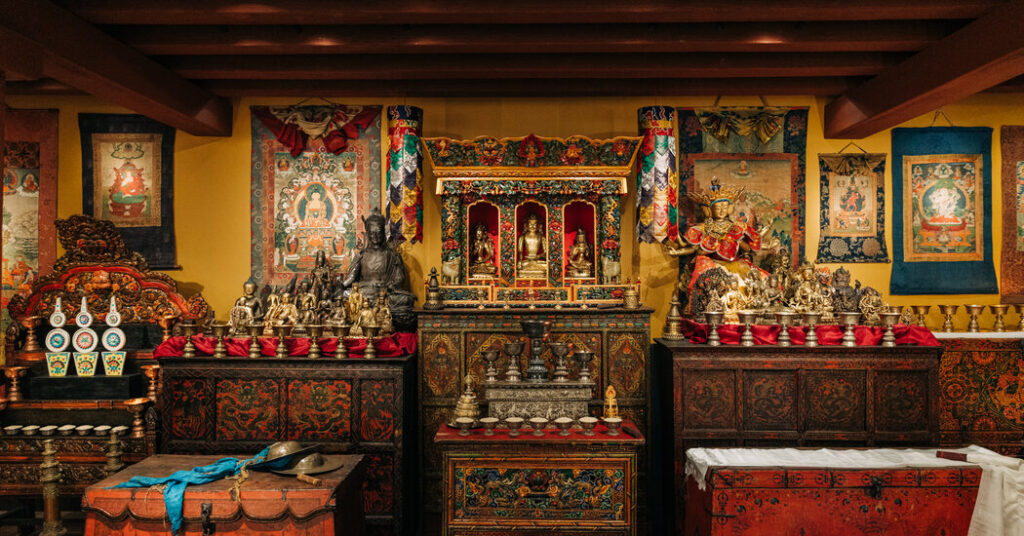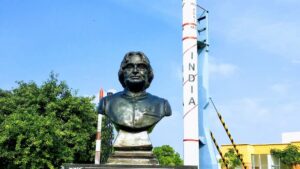When the Rubin Museum Was Divine

A brick-and-mortar presence can be, often is, a crucial part of an art museum’s allure. The Guggenheim’s mother ship interior is such a thrill that it prepares you to love whatever’s on view. The interiors of the Frick and the Morgan are intimate enough to make you feel proprietarily, and fabulously, at home.
The Rubin Museum of Art also has design and art going for it. Housed in what was once the women’s wear wing of Barneys New York, it retains the store’s six-story steel-and-marble spiral staircase, and turns spaces conceived for leisurely shopping into ideally scaled galleries.
And the kind of art gathered in those galleries is, in its concentration, like nothing else in town. Mostly ancient, mostly religious, it’s all from Himalayan Asia, a region that stretches from India to China, and has, on the Rubin’s map, Tibet at its center.
With its suave look, dynamic art assembled over decades by the philanthropists Donald and Shelley Rubin, and customer amenities — a gift shop stocking artisanal goodies, an East-West fusion cafe — the museum was a hit from the day it opened in 2004, and one with a comeback vibe. It was the place you ended up lingering in just because it felt good to be there, in an atmosphere that felt calm but charged, that discouraged hurry, encouraged quiet.
In a few months all that will be gone. The museum recently announced that it would permanently leave its physical space on Oct. 6, having sold the building, with no plans to buy another. It will travel the house collection here and there, maintain a digital presence with the goal of promoting Himalayan culture internationally. It will transition to being, in its own vague words, a “museum without walls.” But from the perspective of a once-frequent visitor to its Chelsea home, I suspect it will become mostly a memory.
The memory will be happy but also troubling. When the Rubin opened, it was one of the very few places in the country — or anywhere, really — where you could find a major collection of historical Tibetan art. Its only American rival in this just happened to be fairly close by: the Newark Museum, with its century-old Tibetan holdings — they first went on view in 1911 — centered on an altar that has been blessed by the Dalai Lama.
(For anyone interest in Tibetan religious culture, a visit to Newark remains an indispensable pilgrimage. And for those New Yorkers who would fly to Asia before they’d take the PATH train to New Jersey, the magnificent Tibetan Buddhist shrine room at the Rubin has been a boon and a popular draw. The museum plans to find new quarters for it after closing, though no location has been announced.)
A particular beauty of the Rubin was that, initially and for a long time, it resisted the lure of New Ageism that its aesthetic focus might seem to invite. Like any serious historical museum, this one was research-driven, intent on lighting its beautiful objects with new knowledge. In still-understudied fields of Asian art its contributions, through shows and catalogs, have been invaluable.
And its curatorial reach soon expanded beyond Tibetan Buddhism. In 2008 came a survey, possibly the first major one, devoted to the religious culture called Bon, which existed before Buddhism arrived on the Tibetan plateau. And there were two unforgettably moving shows exploring the art of religions that originated in India but had a global presence: Jainism and Sikhism.
Among viewers attracted to these two shows were practitioners of the religions. Their presence forged a link between the museum-as-archive and a world of living spirituality, in much the same way that, a decade earlier, exhibitions like “Face of the Gods: Art and Altars of Africa and the African Americas” had brought devotees of Santeria and Candomblé into another of the city’s maverick institutions, the Museum for African Art in SoHo.
Added to all this was the Rubin’s early attention to 20th- and 21st-century material. Its founding curator of modern and contemporary art, Beth Citron, organized three eye-opening exhibitions devoted South Asian modernism. She also initiated on-site residencies for young Asian and Asian American artists, among them the wonderful Brooklyn-based Chitra Ganesh.
Over time, though, the institution’s strengths have undergone erosion. In 2019, there were staff cutbacks and departures. (Citron is now curator of modern and contemporary Asian and Asian Diaspora Art at the Asia Society Museum.) The once-rich program of scholarly shows thinned. New Ageism crept in in the form of audience-participation projects like “OM Lab,” in 2017, and the current, virtually art-free “Mandala Lab,” an “interactive space for social, emotional, and ethical learning” that occupies the museum’s entire third floor.
No doubt many factors — financial stress, repatriation concerns, audience falloff from Covid, and the vogue for museum “experiences” over objects — have been at work. But the reality is that the Rubin, as it exists today, feels like a diminished version of what it once was.
Its farewell Chelsea offering, “Reimagine: Himalayan Art Now,” installed over six floors, seems designed to clinch the institution’s identity as a museum of the present, not the past. With three curators — Michelle Bennett Simorella of the Rubin; Tsewang Lhamo, founder of the Yakpo Collective of Tibetan diaspora artists in New York; and Roshan Mishra, director of Taragaon Next, a private museum in Kathmandu, Nepal — the show features 32 artists of Asian descent, most from the Himalayan region, doing work related or in direct response to items in the museum’s historical collection.
As is the case everywhere at present, there’s a lot of illustrational figurative painting — examples by Bharat Rai (Nepal), Prithvi Shrestha (Nepal), and Tenzin Gyurmey Dorjee (India) stand out — along with high-polish digital work, including animated images of nonbinary Buddhist-Hindu avatars by the Chinese-born LuYang.
Some artists make references to spiritual and ritual continuance. Sonam Dolma Brauen does in a group of mold-made clay funerary mounds or stupas displayed around the base of a large antique copper stupa from Tibet. And so does an artist called Imagine (Sneha Shrestha), in an arrangement combining ceremonial vessels from the Rubin collection with almost identical examples, bearing traces of active use — candle wax and incense ash — from her family’s home altar.
Such balances of old and new are subtle and telling. But too many times in a lbumpy but interesting show — one that introduces a range of contemporary artists we likely would not otherwise see — new art overshadows old, literally in the case of barely visible centuries-old paintings that can only be exhibited with protectively low lighting. The big, accessible Now dominates a recessive, endangered Then.
Museums disappear, even when brick-and-mortar stands. After a series of organizational fumbles, the Museum for African Art, source of some of the most conceptually daring exhibitions of its era, vanished. Technically, on paper, it still survives as something called the Africa Center, which is housed in a high-rise on upper Fifth Avenue and appears to have only tangential connections to art. Anyone who experienced — which means was educated by — the original museum knows that it’s long gone.
The Rubin Museum isn’t even pretending that it wants to continue as a walk-in entity, as an ambient site of stimulation and contemplation. It is forthrightly promoting its dispersal, declaring itself, in effect, a mail-order house of art and ideas. Chunks of its collection are already traveling to university galleries, which is good. The fact that its most in-demand export now seems to be “Mandala Lab” — versions have appeared in London, Bilbao and Madrid — serves as a reminder that the museum has, for some time, not been what it once was.
And what it was, was one of this city’s walk-in, sit-in, dream-in treasures, companionable in atmosphere, singular in cultural focus, comfortable with the idea of devotion in all its forms. Too bad to have to say goodbye to that.
Reimagine: Himalayan Art Now
Through Oct. 6, Rubin Museum, 150 West 17th Street, Manhattan, (212) 620-5000, rubinmuseum.org.
when-the-rubin-museum-was-divine





